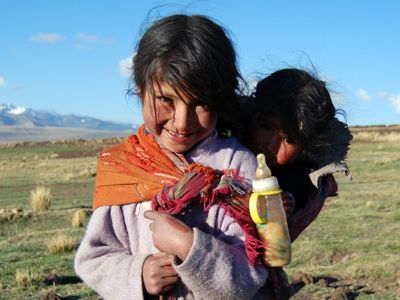The dire situation in Southern Peru continues due to the extreme temperatures in the region of Puno. Isabel Guerra writes in Living in Peru, the most vulnerable victims are children, who are dying from pneumonia and respiratory illnesses. To date, there have been 433 registered deaths due to the cold [es]. This is in comparison to the 480 deaths across Latin America due to the AH1N1 virus, which has received much more media and governmental attention.

Photo by Barbara Drake and used with permission. http://americaninlima.com/2009/07/18/andean-children-cold
However, there have been some strong and powerful images emerging from the region, including this video, that show the victims of this cold wave, which has caused quite a reaction from some Peruvians.
The harshness of the video impacted those that saw the video, which is shown in the comments section by those who criticize the journalists who made the video. For example, the YouTube user named beto1726 writes:
How morbid can these journalists be, when they see (the situation) and not do sh** if they knew that they would find children suffering, why did they not take medicine from Lima, taking up a collection from all of the employees at their station
The user Piacostar responds on behalf of the journalists:
I don't justify it… but in honor of the truth, journalists are not doctors, or lawyers… we just report… it is the only thing that we can do… and be outraged like the rest of the world… our power does not go beyond showing the crude reality, it is true, waiting for what is revealed and so those that can and SHOULD do something about it, SHOULD DO SO!
It is not only the cold and the governmental improvisation that is affecting the low-income rural population in Puno, but also the poor management of donations received from those with good intentions. Bobsparz from the blog Caviar de Cianuro [es], writes about one example of donations not arriving to their intended destination:
A few days ago, SUNAT (Tax Revenue Superintendency) impounded 32 tons of rice (in 630 sacks) from a World Food Programme donation for the people of Puno. It turns out that the international organization hired the transporters from the company Rice-Growers Industry of America (Induamérica) who then hired the transport company Flores Casas because they did not have the logistical capacity to be able to transport the donations to Puno. The donations went from Lambayeque to Lima, and then headed to Puno in 8 trucks from Induamérica and 3 from Flores Casas. The donations tranported from Flores Casas never arrived and part of the donation was found being sold in a market in the city of Ica.
Because of the theft, 20,000 families in the south who have had to withstand the cold will not be able to receive their corresponding alimentation. In total, in reality it was not 32 tons, but rather 100 tons that were lost along the way from Lima to Puno. Truly shameful.
Corruption is not the only problem that is presented to those who want to help the people of Puno. Barbara Drake, an ex-pat from the United States, writes in her blog An American in Lima:
In any other country, the Red Cross would be on the scene tending to victims and providing emergency services, but guess what? Peru’s Red Cross is a private, family-owned business that operates according to its own idiosyncratic methods, not those of the International Red Cross/Red Crescent Society. The Peru Red Cross does virtually nothing during disasters and even less to prevent them.
Why can’t the International Red Cross intervene and help establish a true Red Cross in Peru? Because the family that “owns” the Red Cross in Peru has registered the name with SUNAT and technically “owns” the Red Cross brand in the country. If you think this is an outrage, join the club. The Peruvian government should intervene, rescind the name from private ownership and help get a real Red Cross established in Peru ASAP.
This situation is complex, and other structural problems are demonstrated during this crisis. Francisco Canaza of Apuntes Peruanos [es] has the opinion that the government's actions in this situation leave a lot to be desired. However, this is nothing new and he writes about some of the deep-seated issues (bold type is the blogger's emphasis):
The donation is only a patch. The real problem is the inattention from the State towards to those faraway areas. The real obligation of the State is to provide sufficient medical services to all citizens. However, simple illnesses lead to death in the mountainous communities because of the absence of timely health services… (but) the mortality is generated because of the low levels of immune defenses in the people because of their limited diets.
Another point: A simple walk through the high-altitude areas burns thousands of calories in a short time. The citizens of the areas of Puno, Cusco, Arequipa, Ayacucho, and Apurimac face extensive walks and their diets are not enough to compensate for the extreme alimentary requirements. The consumption of proteins and calories is low in the mountainous region. The consumption of meat, for example, is also very limited. However, the distribution of milk is often promoted as a grand achievement. Worse yet, they continue to insist in models like “potato bread” which end up being ridiculed for its dietary contribution.






No hay comentarios.:
Publicar un comentario